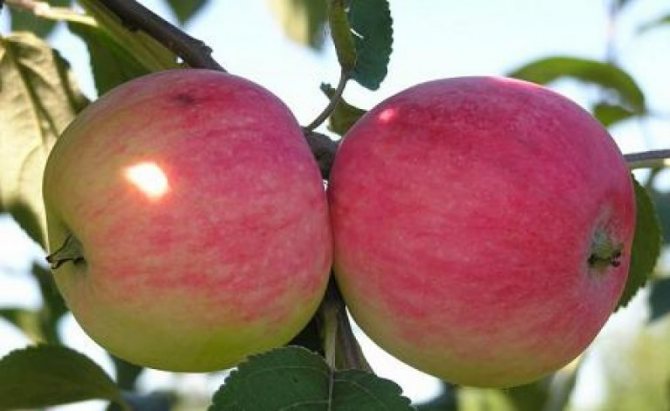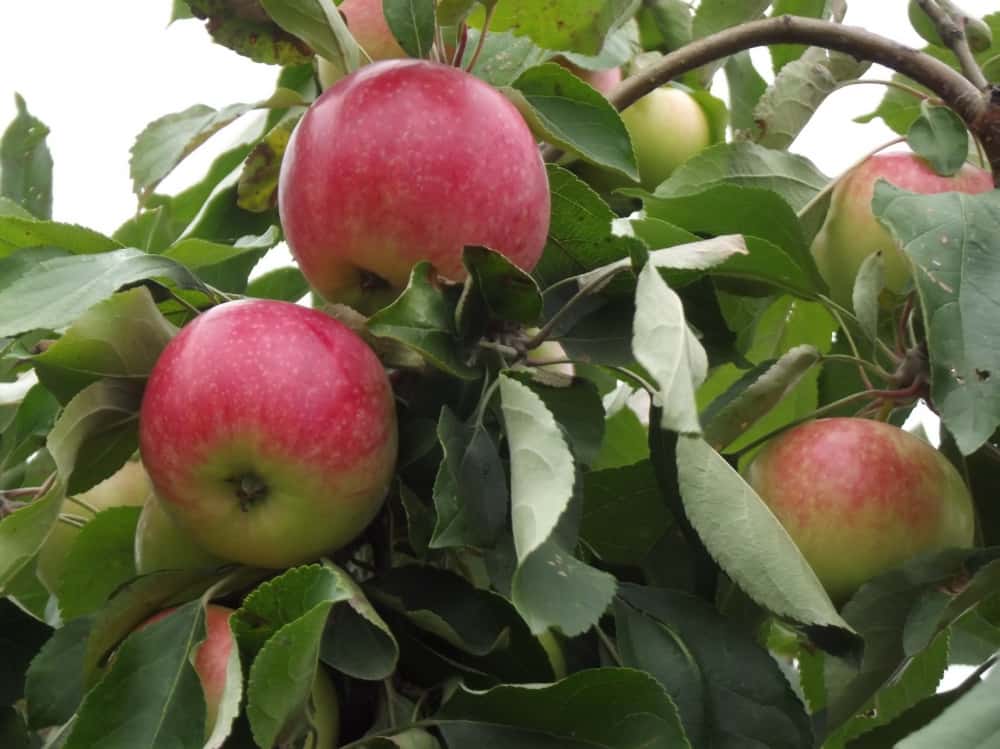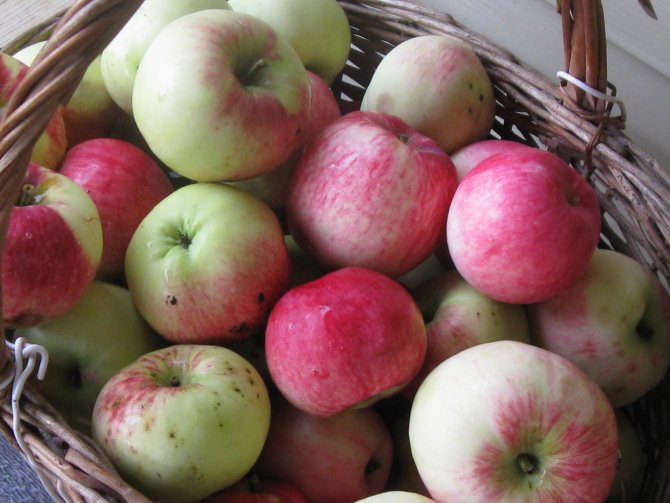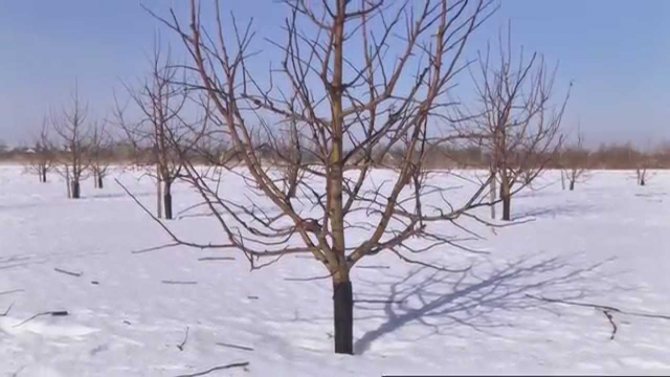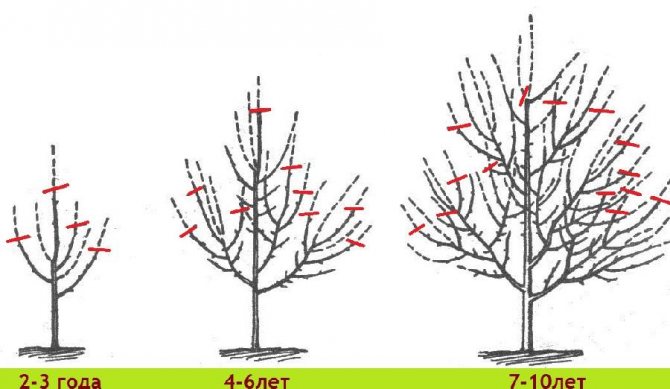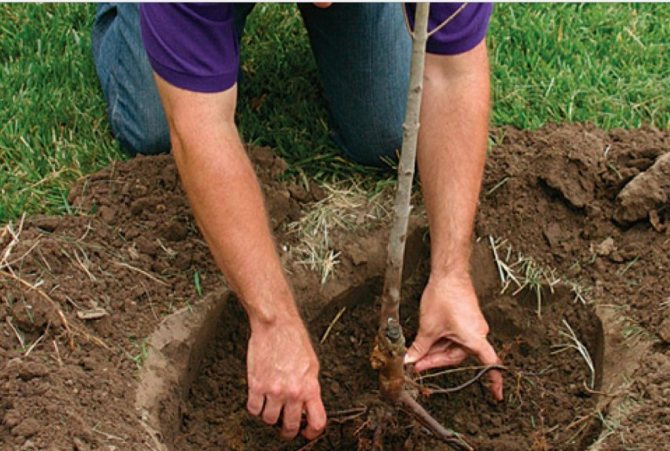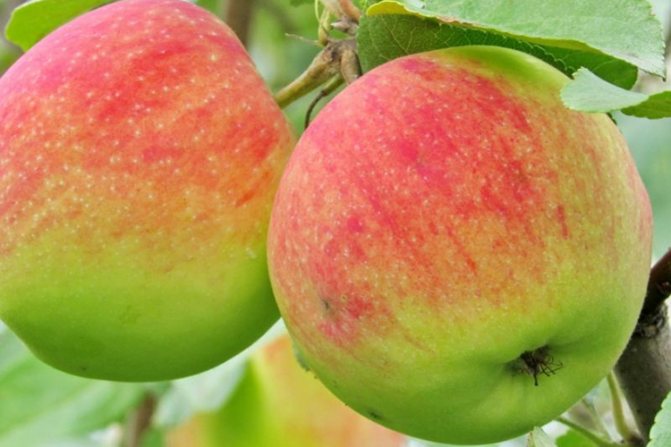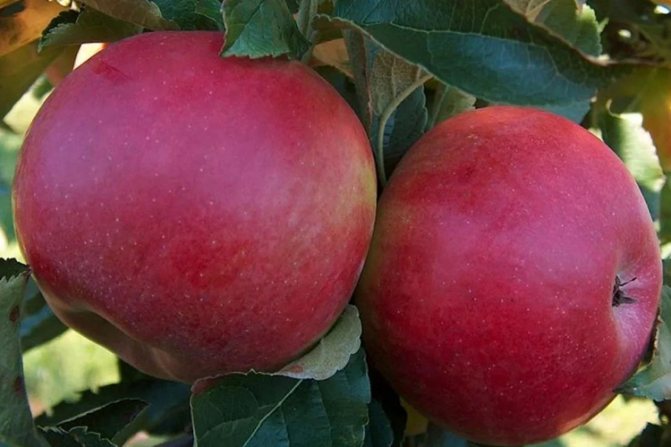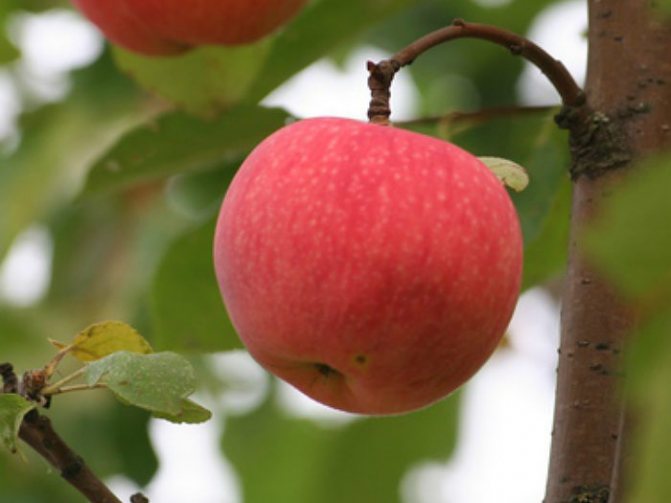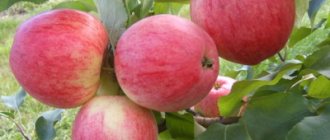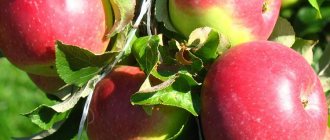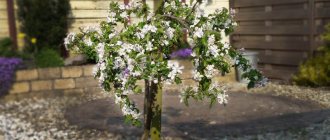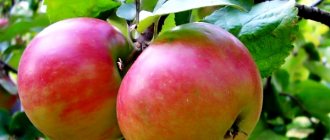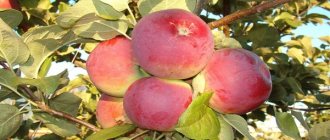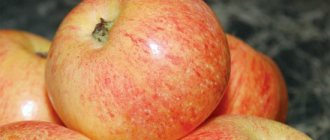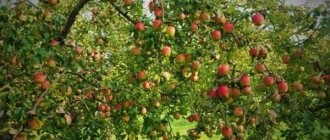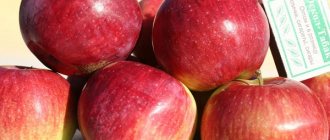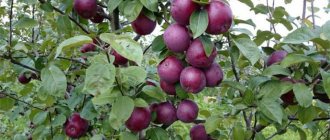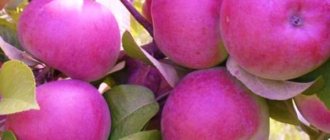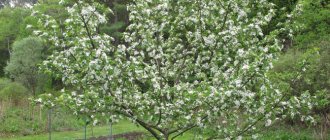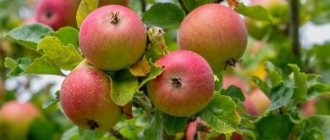The Melba (Melba) variety was developed at the end of the 19th century in the state of Ottawa (Canada). The apple tree appeared with free pollination of the seeds of the Macintosh apple tree. The name Melba was given in honor of the world famous Australian opera singer Nelly Melba. The apple tree was first exported to Europe, then it began to be grown in Russia.
The variety was entered into the State Register in 1947. The variety has not lost its popularity for several decades. On its basis, many new hybrids of apple trees were bred.
Description and characteristics of the variety
History of creation
In 1898, in Ottawa (Canada), a new late summer apple variety was bred at an experimental station. It was created by free pollination with seeds of the Macintosh variety, old and proven. Thanks to its excellent qualities, Melba spread with lightning speed not only throughout America, but was also brought to Europe and Asia. In Russia, this variety has been valued since the middle of the last century, filling more and more niches in people's gardens. During the existence of Melba, gardeners of the northern regions, in order to get an apple tree in the garden and not destroy it, have learned to grow it on a winter-hardy stock, so that nowadays the variety is widespread almost everywhere.
Features of the structure of the tree
Melba is a medium-sized variety, reaching no more than 3 m in height. The crown of an adult tree is spherical, the trunk is thick. In an apple tree up to 3 years old, the structure is columnar, as it grows, the crown becomes rounded, the trunk slightly bends.
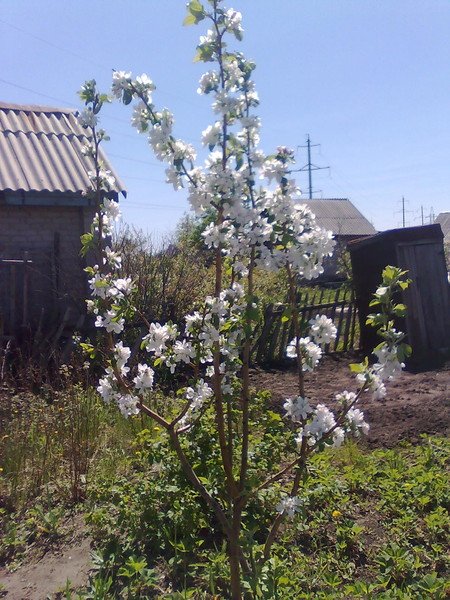
The young Melba apple tree has a columnar structure
The bark of a rich dark brown color with an orange tint, foliage of medium density, light green, sometimes yellowish. The shape of the leaves is oblong with a crenate edge. On powerful and sturdy shoots, the leaves often become convex on the upper side, as if inflated. The flowers are large, the buds have a white-pink tint with a purple tint, the petals are rounded, light pink in color, closed, closely spaced and slightly overlapping each other. Fruits in the bulk are formed on ringlets. Young shoots differ from adult branches in cherry color of bark and slight pubescence.
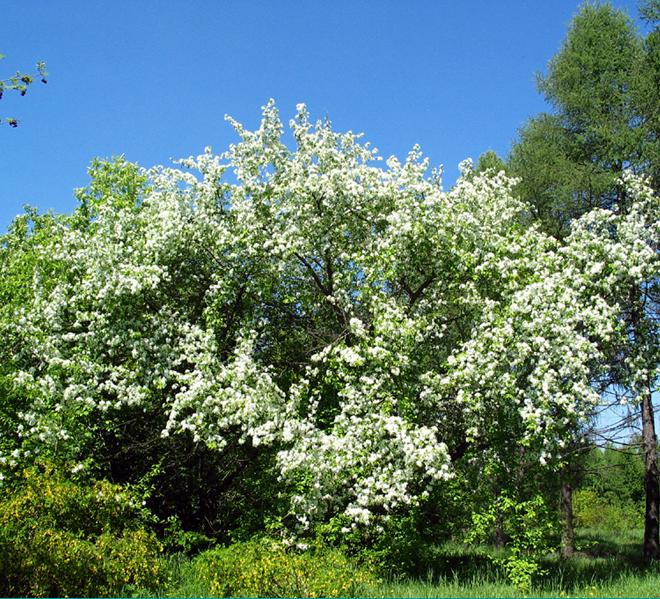

When the apple tree matures and begins to bear fruit, the crown becomes noticeably round.
Melba is characterized by rapid growth, the first harvest is harvested at 4-5 years of age of the apple tree.
Taste and decorative features of fruits
Melba apples compare favorably with their counterparts in many ways. They are incredibly juicy, tender, taste sweet with a pleasant sourness, have a pronounced taste and aroma of sweets.
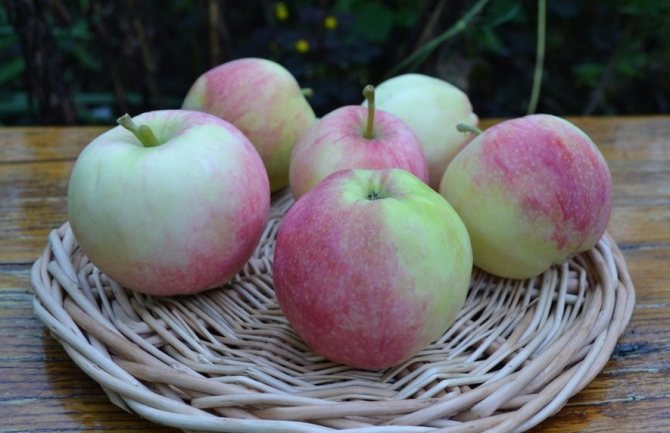

Melba apples are flattened, round or round-conical in shape
Medium sized apples. Their weight is 120-150 g, although sometimes large fruits up to 200 g are found. The skin is yellow, with ripe apples it is half covered with red-pink stripes. The pulp of the fruit is very tender, juicy, snow-white in color. The shape of the apples is round. The fruits have an attractive presentation, and in combination with excellent taste have become one of the favorite varieties of traders. Ripening, Melba perfectly decorates the garden with a combination of soft green foliage with bright apples burning on it.
Video: what does the Melba apple variety look like?
Fruit
Melba apples are quite large - the average weight is about 150 grams. The typical shape is round, the skin is smooth, but may be slightly ribbed.Ripe apples are covered with a waxy coating, which contributes to the good storage of products.
The main color of apples is light green, plucked fruits turn yellowish over time. Ripe fruits have a slight "blush", pronounced on the south side.
The pulp is tender and crispy, juicy. Mostly white in color, but can be greenish - closer to the skin.
Melba apples are great fresh, but for juice, compote or jam, it is better to choose other varieties.
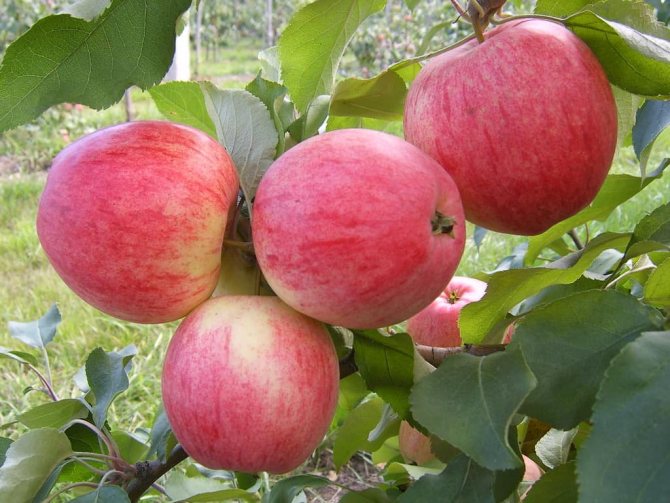

Advantages and disadvantages of the variety
More than a century ago, Melba was prized mainly for its pleasant taste and rich harvest. Over the past time, the attitude towards the variety has not only not changed, but new interesting details about the apple tree have also come to light.
pros
- Early ripening of apples. At the end of August, you can already enjoy delicious and juicy fruits.
- Rapid growth, thanks to which Melba begins to bear fruit as early as 4-5 years after planting.
- High productivity. At the age of 10 years, up to 70 kg of the crop can be harvested from one apple tree.
- Flawless appearance.
- The strength and durability of the fruits, due to which they can be transported over long distances without fear of presentation.
- A rich set of useful properties. Apples contain pectin substances (10.1%), titratable acids (0.78%), sugars (10.5%), ascorbic acid (13.4 mg / 100 g), P-active substances (297 mg / 100 g ).
- Widespread use in cooking.
Minuses
- Average or below average frost resistance, which makes it impossible to cultivate the variety in the northern regions.
- A high incidence of scab disease.
- Low probability of self-pollination.
- In adult apple trees (at the age of 7-8 years), fruiting becomes cyclical, difficult to calculate.
Apple-tree Melba reviews of gardeners
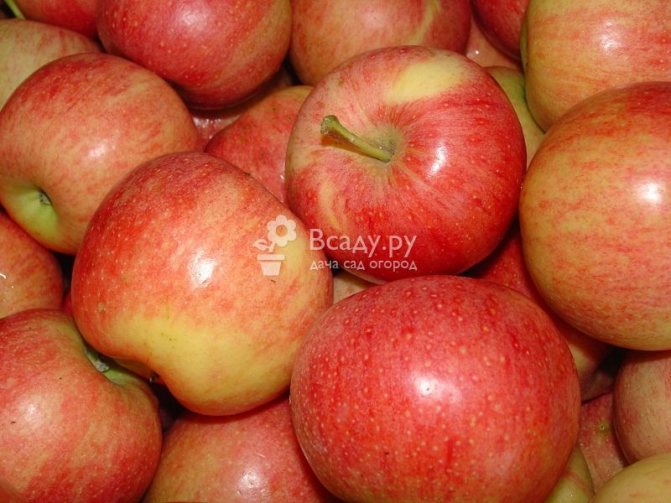

Apple-tree melba reviews of gardeners
Melba apple tree has many positive reviews of modern gardeners, but there are also negative ones. Many are attracted by such qualities of the variety as early maturity and early ripening of apples. Industrial producers appreciate Melba for its good presentation, long shelf life and high taste of the fruit.
Gardeners speak positively of the variety for a generous harvest, since up to a centner of apples can be harvested from one tree. But opinions may differ, because Melba reaches the maximum yield mark only for 10-12 years of life.
Some gardeners are alarmed by the low resistance of the variety to low temperatures, but trees well covered with agrofibre always survive the winter. A lot of trouble is caused by such a common disease as scab. But by following the recommendations from experienced gardeners for the processing of stone fruit crops, problems can be avoided.
Planting rules for seedlings
In order to get a rich harvest every season, it is worth following certain rules when planting an apple tree. The Melba variety, like the others, has its own nuances that must be taken into account when planting in the garden.
When to plant?
Planting young trees is best done in autumn (late September - early October). It is very important not to be late so that the seedling has time to take root properly before the first severe frosts. It takes about a month for an apple tree to take root, so it's worth calculating the timing.
Which soil to choose?
Since a strong frost can destroy this delicate apple tree, the Melba variety is not widespread in Russia beyond the Ural region. Melba develops well and bears fruit in central Russia, in the Volga region and in the Caucasus.
The apple tree gives a good harvest if planted in loamy soil. To artificially create the necessary soil under the apple tree, a mixture of sand, compost or rotted manure and peat crumb is poured into the planting hole in equal proportions.
How to plant?
If the seedlings are thin and weak, then before planting it is worth holding them for 2-3 days in a bucket of water to fill the stems with moisture. The crown of the apple tree is exposed by removing the foliage, and the branches are tied up, preventing the evaporation of the liquid.
A young tree is placed in a planting hole with a diameter of 1 m and a depth of 80 cm, covered with a prepared mixture or loamy soil, and covered with the root collar. If the seedling is weak, then a stake is first driven into the pit, to which the apple tree is tied.
After planting, the ground in the near-trunk circle needs to be crushed a little, without tamping too tightly. The seedling should be watered generously at the rate of 1 bucket of water per 1 tree.
What do you need to consider when boarding?
Melba is quite demanding on growing conditions, so moisture stagnation at the roots should not be allowed. Spring melting of snow, close location of groundwater or heavy and prolonged precipitation will lead to decay of the roots and death of the apple tree. If there is a danger of moisture stagnation, then drainage is installed in the tree in the planting hole or the place of growth of the apple tree is artificially raised.
The Melba apple variety does not like drafts, and also requires sufficient lighting, so you should choose a sunny site for planting.
The nuances of growing and questions from readers
In the process of growing an apple tree, gardeners in different regions of the country have questions:
When to plant: in spring or autumn?
The most favorable time - fall, but many gardeners plant in the spring, fearing the death of the apple tree during the autumn planting, caused by the fact that the apple tree does not have time to take root before the onset of frost.
When planting an apple tree in the spring, it is recommended to prepare the pits in the fall, for autumn planting - a month before the event.
In autumn landing is performed after the end of the fall, in the spring – depending on weather conditions.
How to form a crown?
The crown is formed by performing sanitary plan cuts, carried out in spring and autumn in accordance with the above scheme of anti-aging pruning, as well as for crown formation:
- In a young tree, the central shoot is shortened by one third, the lateral branches are cut at the level of 2-3 buds;
- Then, within 2-3 years, they continue to cut off the main shoot by a third of the length, and on the branches that form the skeleton of the tree, they leave shoots growing at an angle of 45 °;
- The rest are cut to the first bud.
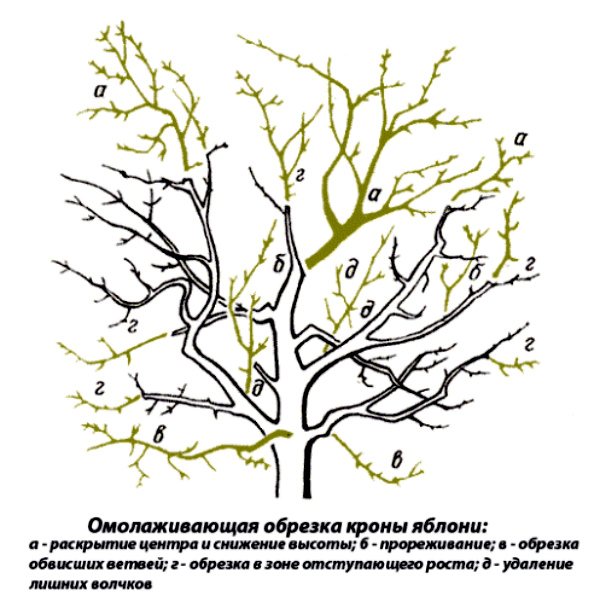

Crown formation scheme.
How do you prune in the fall?
Remove in autumn damaged branchesthat can break off from the weight of the fruit, dry and diseased branches.
What are the features of growing Melba?
Loamy, fertilized soils and groundwater drainage. The landing site must be protected from the wind, be sunny and open.
What is the distance between the apple trees?
Distance between apple trees should be 5-6 meters and 6-8 meters between rows.
However, in each specific case, it is necessary to take into account:
- Features of the site;
- Region of residence;
- The nature of use (industrial, individual).
How to grow in the regions?
- In the middle lane - the variety is perfectly zoned and does not require any additional knowledge for successful cultivation.
- In Siberia - requires the arrangement of an appropriate shelter for the winter and planting from the leeward side, otherwise the growing conditions do not differ from the usual ones.
- Planting the Melba apple tree in autumn in the Urals produced in late autumn. Choose fertile soil with deep groundwater. For the winter, the near-stem circle is covered with peat and humus, and on top - with leaves and snow.
- For the Moscow region and the Leningrad region - needs additional care due to possible scab infestation, especially during prolonged periods of rains. To protect against frost, care should also be taken to protect the tree.
- For the southern Urals - cultivation in this region does not differ from those recommended by breeders. According to the gardeners of this region, Melba is a “sweet” variety of the South Urals.
General recommendations are: there are no special differences in cultivation.
The only rule is that in places where prolonged frosts are possible, it is necessary to cover the tree and take preventive measures against such a disease as scab.
Which variety is better: Candy, Mantet or Melba?
Which variety is better, every gardener chooses for himself individually depending on the region of residence and personal preferences. Below is a table for comparing these varieties when grown in the Samara region:
| Name | Taste, points | Sugar to acid ratio,% | The beginning of a mature carrion | Picking the last apple | Fruit diameter, mm |
| Melba | 4,3 | 16 | August 10 | August 31 | 69 |
| Mantet | 4,5 | 16 | July 25 | August 31 | 59 |
| Candy | 4,4 | 30 | 5th of August | September 2 | 65 |
Seasonal rules for caring for an apple tree
After planting, the apple tree needs careful care, consisting of timely pruning, feeding, watering and treatment from pests and diseases.
Pruning
The pruning procedure is recommended in early spring before sap flow begins. So that the fruit branches are more likely to be laid, and the growth of lateral shoots is accelerated, the central conductor is shortened by a third. It will also make harvesting easier as the mature tree grows taller and taller, and pruning transfers the apple growth to the side branches.
The Melba variety requires rejuvenation, which must be carried out very carefully, removing 2-3 age shoots per year. Sanitization includes pruning dry branches and thinning the crown, as well as removing root growth. If fresh branches are cut off, after which a wound remains on the bark of the tree, it must be covered with garden varnish or water-based paint.
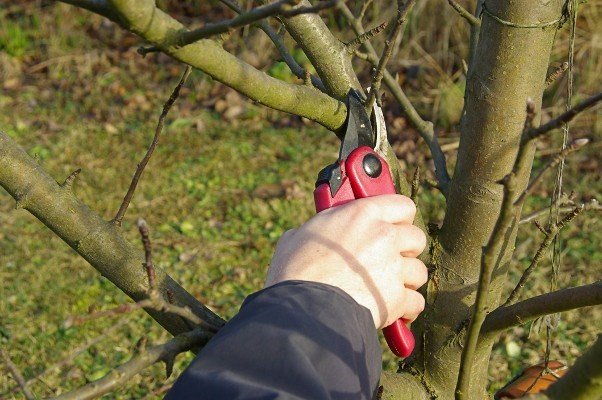

Pruning tools must be clean to avoid introducing dirt into the wound.
Garden pitch can be purchased at a specialized store, or you can make your own. To do this, take one part by weight of rosin (50 g), the same amount of beeswax, add 200 g of unsalted fat or sunflower oil. Combine all ingredients and, stirring occasionally, melt over low heat. Then remove the mass from heat and stir until smooth. Transfer the finished var to jars with a lid. It can be stored for up to 10 years.
Experts advise adding 1 crushed tablet of heteroauxin per 1 kg of mass to it before hardening a home-made garden varnish, which accelerates the healing process of tree wounds after pruning branches and covering the cuts with varnish.
Video: pruning and shaping the crown of an apple tree
Top dressing
The first feeding of Melba is carried out in early spring before flowering. As with planting, the earth near the trunk of the apple tree is dug up with humus or compost (about 2 buckets per apple tree). Also, before flowering, fertilizers are added in a complex or separately:
- 1 glass of wood ash;
- 1/3 cup potassium chloride
- 1 cup superphosphate
During the summer, Melba should be fed three times with nitrogen-containing fertilizers in liquid form, with a break of 2-3 weeks. For feeding, manure and chicken droppings are suitable (1:10).
When the fruit ripens, it is necessary to limit the tree's access to nitrogen so that the apple tree can prepare for wintering. Melba is also fed after harvest, in the fall. 40-50 g of potassium chloride is added to the soil per tree. 2 buckets of compost under each apple tree will not harm either.
Watering
Since Melba does not tolerate abundant moisture, it must be watered carefully. In the spring, the land is filled with melt water, but in the summer the apple tree needs to be watered once a week - from 10 to 20 liters per tree. If the summer is rainy, watering is reduced until dry weather sets in. In mid-August, regular watering is stopped, moistening the apple tree trunk circle, if necessary.
Description of the tree
This is a fast-growing variety with high yields. At the same time, the trees are rather small - about three meters in height. There is a dwarf species. Its height rarely exceeds 2 meters.
The crown of the tree is spreading, slightly raised. The density is medium, so the tree does not need frequent thinning.Usually, experienced gardeners recommend thinning it no more than once every 2 years. Circumcision begins from the 4th year after planting the seedling.
The type of fruiting is mixed. Fruits appear most often on spears and ringlets. More than 70% of the total crop is formed on the ringlets of the branches that extend from the tree trunk at an angle of 90 degrees.
The tree trunk is powerful. Every year it becomes more durable and massive. Gradually overgrown with a large number of branches that depart from it at an angle of 90 degrees.
The bark is dark brown in color, with a slight orange tint. The branches of the seedlings are straight, of "perfect shape", without defects.
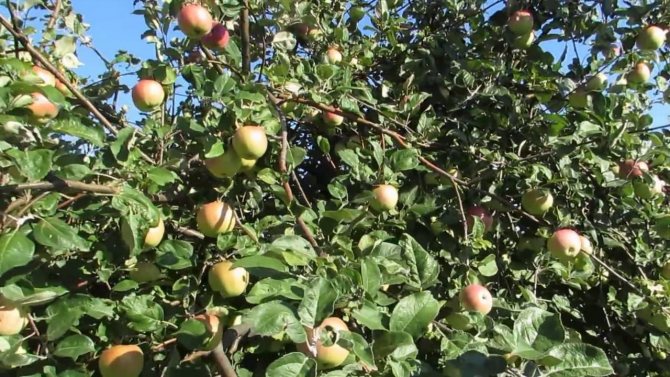

Shoots of relatively small thickness and length, covered with intense pubescence. Elastic, so they do not break under the weight of the crop. With a strong harvest, the shoots do not break, but tend to the ground, but experienced gardeners still recommend tying them up or using supports.
The leaves of this variety are oval in shape. Oblong. Slightly curved and light green. Convex leaves grow on more developed shoots.
The inflorescences are large, with pink-white buds. The flower petals are rounded, tightly planted to each other. The tips of the pistils are below the stamens or at the same level with them.
Flowering begins in the month of April. This is a big problem in temperate latitudes, as early blooming is faced with frost. The variety itself is not frost-resistant. Therefore, it is recommended to grow Melba in warm regions.
Protection from pests and diseases
Melba is a fairly resistant, but at the same time gentle variety that always tries to adapt to new growing conditions. The change in conditions for the transportation of the apple tree to Russia was insignificant, and its attitude towards pests and diseases remained the same as in Canada.
Pests
The most dangerous for a tree are wood pests, which damage the bark, getting to the vulnerable trunk. These are scale insects, bark beetles, ticks and other pests. Caterpillars and beetles spoil the green foliage of the apple tree, aphids suck the sap from the tree, and the fruit moths eat the fruits. It is quite difficult to destroy pests without harming the apple tree, therefore it is important to take the necessary preventive measures in time.
In the middle of spring (before flowering) Melba is treated with preparations in order to exclude the appearance of pests that woke up after wintering in the bark of an apple tree. The following drugs are used for processing:
- 40 g Inta-vira for 1 bucket of water for each tree;
- 1 tablet of copper oxychloride in a bucket of water (solution for 2-3 apple trees).
To prevent the appearance of pests, the apple tree trunk is whitened, which is simple and effective.
To prepare a garden whitewash, you need to dissolve 2.5 kg of lime and 0.5 liters of copper sulfate in a bucket of water, and then add 200 g of wood glue.
First, they examine the tree trunk, clean it with a scraper or a wire brush from moss and lichens, and scrape off dry old bark. After that, you need to cover up all the cracks with garden pitch. Then you can proceed directly to whitewashing. They use a brush or spray gun. Trunks, skeletal branches and tree forks are whitened.
Important! No whitewashing is needed for young trees with smooth bark. It can clog pores and harm them.
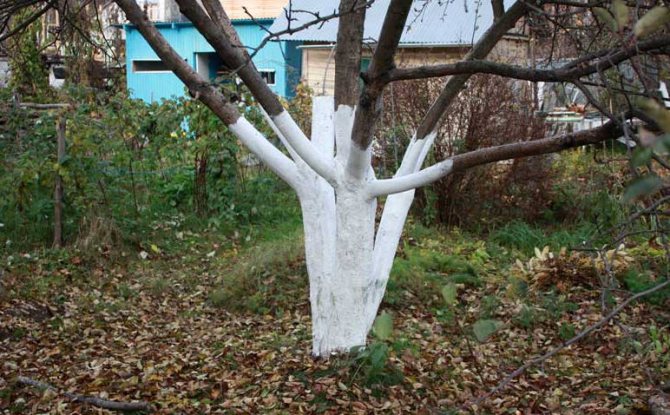

Whitewash trunks and lower skeletal branches, preferably 2-3 times a year
Before wintering, the trunk of the Melba is sheltered from rodents, for example, with old nylon tights or a thick layer of insulating material. You can use stems of raspberry, willow, hazel, thin cherry twigs. Roofing material, roofing felt, wire mesh, pretreated in a solution of lime or chalk, are also suitable for strapping. If synthetics are used, then under it it is necessary to tie sackcloth or matting to exclude contact with the bark of the apple tree.
Diseases of the apple tree
Melba is resistant to all diseases of apple crops, except for scab, which often and extensively affects it. To prevent this disease, it is necessary to prune trees on time, apply fertilizers, remove fallen leaves, preventing its decay at the roots.
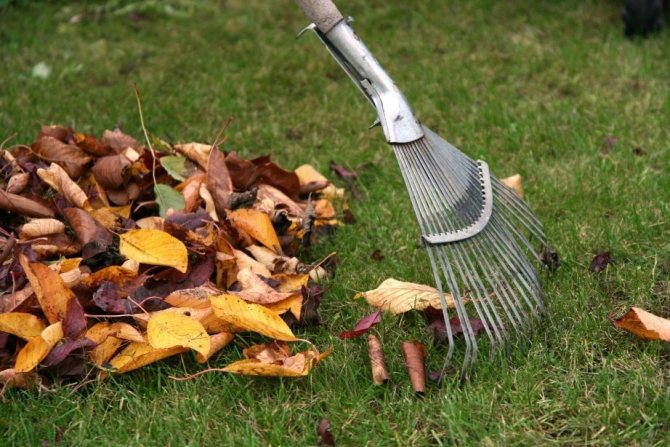

Cleaning and destruction of fallen leaves near trees is a necessary measure for the prevention of scab
Melba is also subjected to chemical treatments in 3 stages. The first treatment is carried out during the budding period: once a 10% solution of ammonium nitrate is sprayed on the trunk circle, and the tree is sprayed with a 2% solution of Bordeaux liquid. The treatment is repeated at the same dosage during flowering and during fruit setting 3 weeks after the 2nd treatment. These measures, if not excluded, will significantly reduce the risk of scab damage.
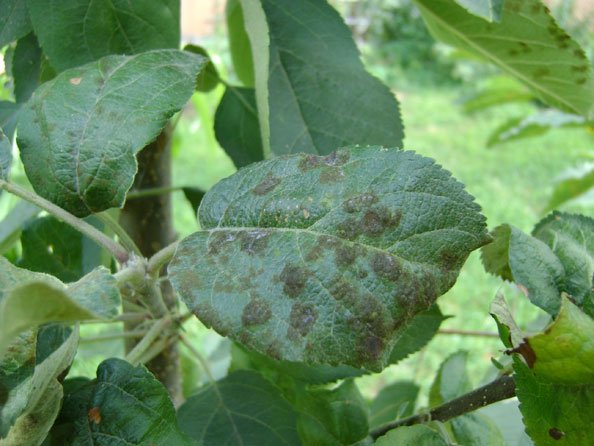

Apple scab is caused by pathogenic fungi, in which spots, warts, peeling of integumentary tissues form on the stems, leaves and fruits
If the scab still prevailed over the trees, it is urgent to take action:
- 10 tablets of the biological bactericide Gamair should be dissolved in 10 liters of cold water. Spraying is carried out up to 3 times per season.
- 20 ml of a systemic preparation of natural origin Phytolavin is dissolved in 10 liters of water. The prepared solution is used for 4 treatments per season at intervals of 15 days.
- Dilute 2 ml of Strobi fungicide in 10 liters of water. It is necessary to carry out at least 3 sprays per season.
- Dilute 3 g of Horus fungicide in 10 liters of water. The spraying procedure is recommended to be carried out 2 times - before bud break and after flowering. A feature of the drug is that it is not washed off during rain.
- It is believed that mineral fertilizers are no worse than chemistry in the fight against scab. In addition, they are at the same time foliar feeding. For treatment, highly concentrated solutions of 10% ammonium nitrate, 10% ammonium sulfate, 15% potassium salt, 15% potassium nitrate are used.
Photo gallery: preparations for the treatment of apple scab
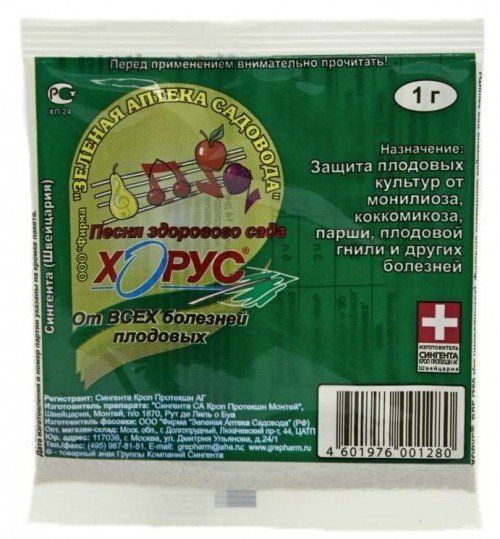

Horus is an effective fungicide with a unique mechanism of action against scab, powdery mildew, moniliosis
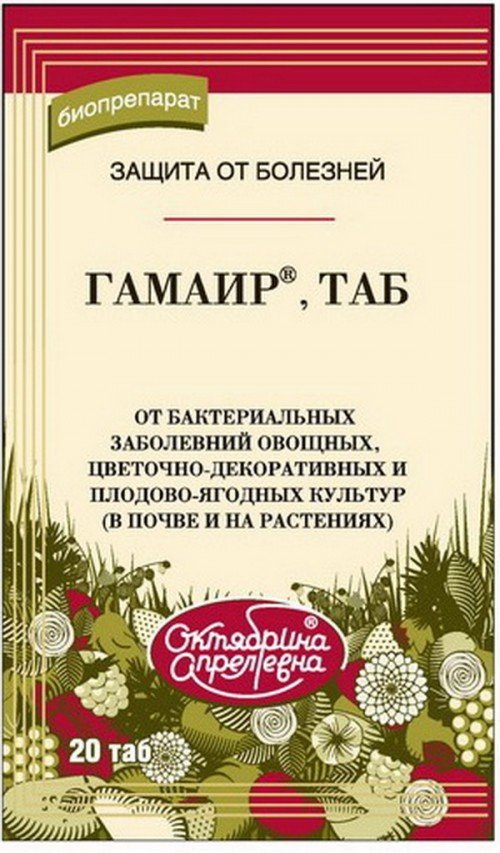

Gamair effectively suppresses fungal and bacterial diseases
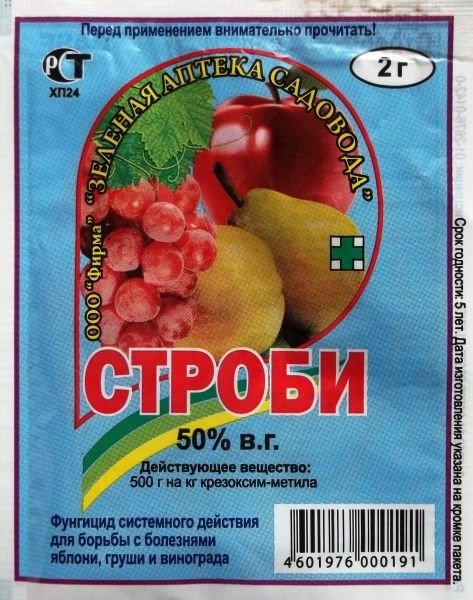

Strobi provides an effective fight against fungal diseases of various types
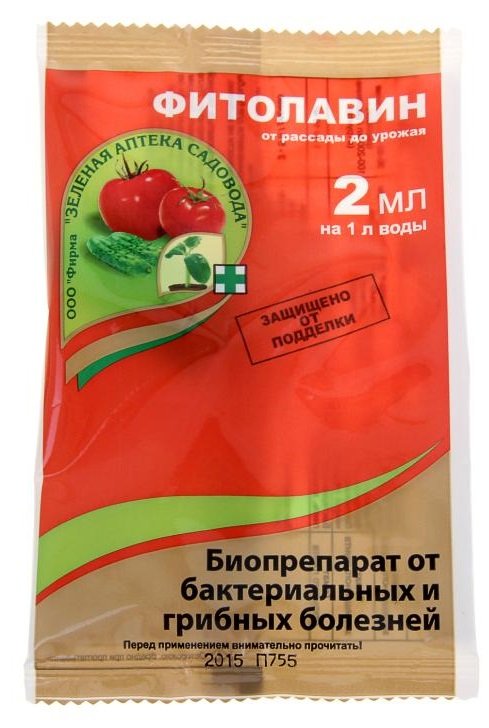

Fitolavin has a pronounced bactericidal and fungicidal effect
Pollination
Melba belongs to self-fertile varieties, but it performs this function poorly, therefore it is advisable to plant pollinating varieties on the site. For Melba, varieties such as Antonovka, Suislepskoe, Borovinka, Stark Erlist and Bellefleur-Chinese are best suited.
Photo gallery: the best pollinators for the Melba cultivar
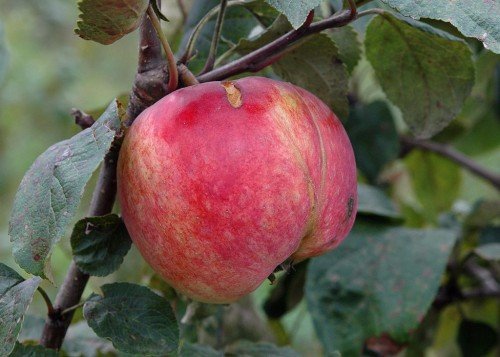

Fruits of the Suislepskoe variety are flattened, with a very beautiful bright integumentary color
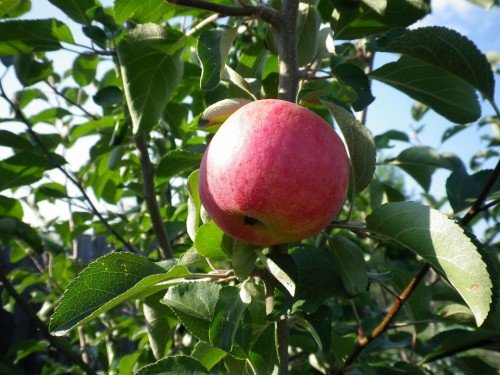

Stark Erlist - early summer variety of American origin
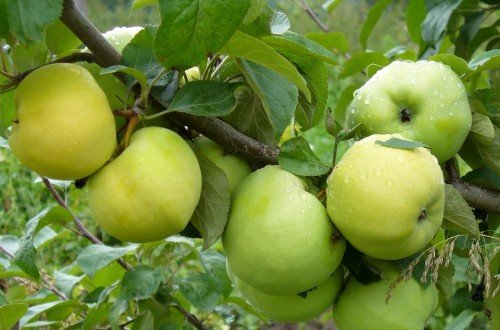

Antonovka is a widespread old Russian winter variety of apple trees.
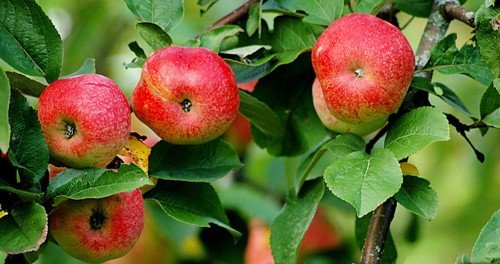

The main advantage of the Bellefleur-Kitayka variety is the high commercial and consumer qualities of the fruit.
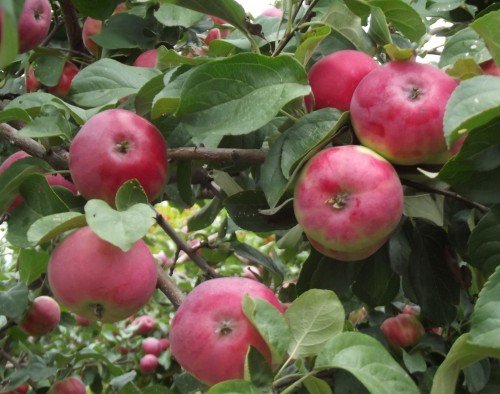

Borovinka - an old autumn Russian variety of folk selection
Winter preparation
Apple trees at an early age need to be insulated, otherwise freezing cannot be avoided.
This procedure is started a month before the onset of autumn frosts. First, fallen leaves, carrion, plant residues are removed in the garden, and the soil is deeply dug up. Then the lower part of the trunk and skeletal branches are treated with slaked lime with the addition of a fungicide.
Mulch with peat or last year's manure. The stem is wrapped with foil, then a chain-link to protect it from damage by hares. The crown is wrapped in burlap, roofing felt or insulated with spruce branches.
With the arrival of spring, when the snow melts and the above-zero temperature stabilizes, the covering material is removed.
Storage and harvesting rules
With proper care, about 80-150 kg of apples can be harvested from one adult tree per season, each weighing 100-150 g. Good transport qualities allow Melba to delight consumers in the northern regions of Russia.
The beginning of fruiting
A young apple tree begins to bear fruit at 4-5 years, a full harvest is obtained at 8 years of growth. Melba is a summer variety, harvesting begins in mid-August. Most of the fruits ripen by the end of the month.
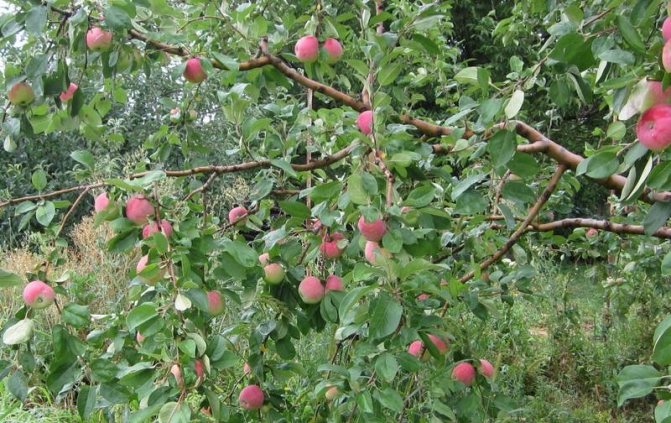

Young trees bear fruit annually, old trees - periodically
Harvesting
Melba apples are recommended to be picked slightly unripe to extend their shelf life. The variety is not prone to early abscission, so the fruits on the tree can hang until overripe for 2-3 weeks. Harvesting in the absence of apple tree formation is slightly difficult, since the tree has a compact crown and short stature, and the fruits are far from the trunk.
Terms and conditions of storage
The collected fruits are carefully sorted out so as not to damage the wax coating on the skin of apples, exclude the affected and overripe ones. After this procedure, the apples are stored in a cellar with a temperature ranging from 2 to 5 degrees. The shelf life of Melba is 2-3 months (sometimes the fruits are stored until January).
Damaged apples are not used for storage, using them in processing for making jams, preserves, juices. Also, the fruits of Melba are used for the preparation of dried fruits.
Yield characteristics
In different regions, different harvesting times, on average, work is carried out from mid-August. Fruiting begins in the second year after planting a seedling grown on a dwarf rootstock, and in the fourth or fifth year, if the tree grew on a vigorous rootstock.
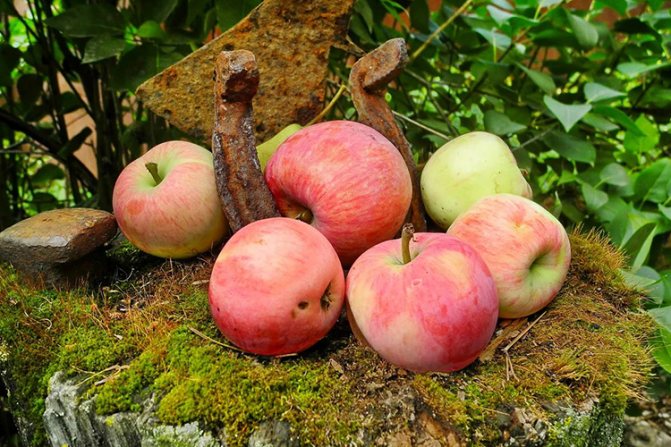

Fruiting in young trees is annual, in old trees - once every two years.
The yield, when planted in the 8x3 m scheme in trees up to six years of age, can reach 93 centners per hectare, When using the 7x7 m scheme, the yield can reach 180 centners / g, but only if the trees are older than six years.
Varieties of the Melba variety
In addition to the main variety, which has retained its characteristics from the Canadian ancestor, Melba also has varieties.
Melba's daughter
This variety was bred on the basis of Melba and has a much higher frost resistance than the parent variety. It is also less affected by scab. The shelf life of apples does not exceed one month, after which the fruits begin to deteriorate. In appearance, they differ from Melba by the presence of pink spots or stripes over the entire surface of the fruit. The average weight of an apple is 130 g. Each tree 10-12 years old is capable of producing 30-35 kg of harvest.
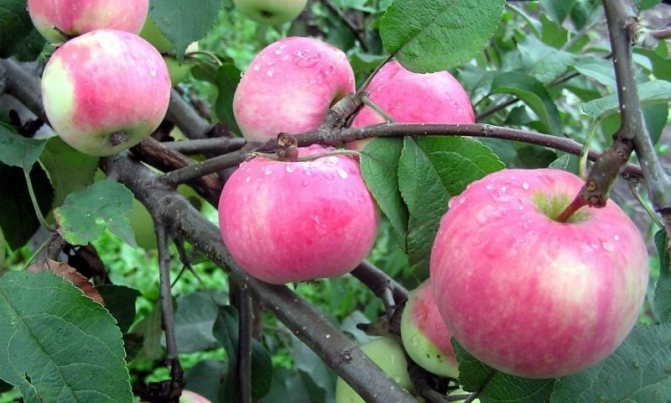

Melba's daughter surpasses her grandparent in winter hardiness
Melba Red or Red Melba
This variety is considered to be a Melba clone, which differs only slightly from it. The color of apples is greenish-white, with a blurred bright red peculiar blush. There are subcutaneous points all over the surface. The fruit tastes less sweet, without a pronounced candy aftertaste and aroma. The variety is suitable for the preparation of compotes, fruit drinks, jelly and fruit wine. The average fruit weight is 150-200 g. The yield of each adult apple tree at the age of 10 reaches 80 kg.
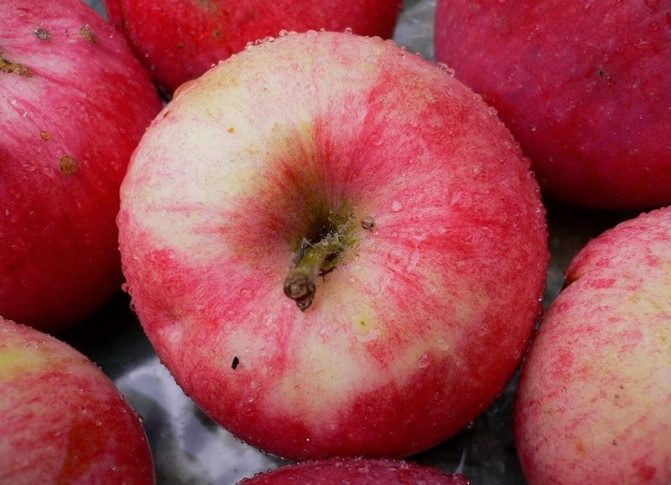

Red Melba is distinguished by abundant fruiting
Dwarf Melba
This species is the original Melba grafted onto a dwarf rootstock from zoned apple varieties. Thanks to grafting on a strong plant, Melba can thus be grown in the Urals, the Far East and Siberia, since the stock used to frost will not let it freeze. The advantages include simplified harvesting, as the growth of the tree is reduced. Melba on a dwarf rootstock begins to bear fruit as early as 2-3 years of growth, and it can be planted in the spring-autumn period due to the high survival rate of the root system of the rootstock. The weight of apples does not exceed 120 g, and the yield from one apple tree reaches 20-25 kg.
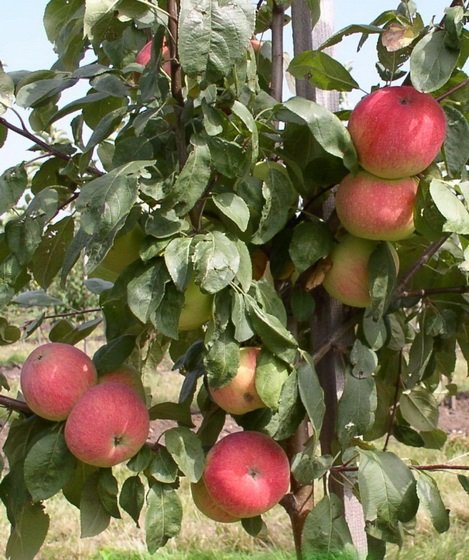

The fruits tolerate transportation relatively well for the summer variety and can be stored in the refrigerator until November, and sometimes until January.
Melba-based varieties
With the help of Melba, several varieties were bred, adapted to the environmental conditions of Russia and the countries of the former USSR. These are such varieties as Zavetnoye, Early scarlet, Caravel. They are very similar to their ancestor, but not as tender and can be grown in any region.
Melba is a favorite of many gardeners. Every connoisseur of taste should plant an apple tree in the garden with fruits of amazing taste and an excellent annual harvest. Without requiring special care, Melba will decorate every site and give many juicy and healthy fruits.
Disadvantages of culture
But, this variety has not only advantages. By the way, this culture also has disadvantages in the form of:
- Weak resistance to frost.
- This apple tree does not have a stable immunity to such a defect as fruit rot.
- The cultivar has a poor self-pollination rate, for this reason it often needs artificial pollinators. As a rule, summer residents come up with pollination for the apple tree themselves.
And finally, the first years of growth, the crop gives a good harvest, then Melba begins a cyclical period. In other words, it gives a harvest for certain years, which are difficult to calculate on your own.
Ripening terms
As you already know, this variety is summer, which means that its fruits ripen quite early. Nevertheless, it all begins, of course, with flowering, which occurs even in the very early spring.
The flowers are distinguished by their rather large dimensions, especially compared to the rest of the tree.
As for their color: it varies greatly (from snow-white to pale pink with light purple tints).
The first ripening of fruits occurs in the fourth or even third year of life. From now on, up to eight years, the tree has been constantly improving its performance and giving more and more apples every year.
Fruits ripen approximately in the middle - end of August. Sometimes, in very bad weather, this date can be postponed even to the beginning of September, however, believe me, this is a great rarity.
In addition, it is important to understand that the fruits do not ripen at the same time, and therefore you will have to harvest for at least a month and a half from the day the first apples appear.
If you do not collect the fruits in time, then, of course, they will begin to fall off. However, if you pluck them directly as they ripen, then you will have an excellent opportunity to store them even for some months, which is an amazing result.
As for the taste of just ripe fruits: it is the perfect blend of sour and sweet. However, since the sourness sometimes upsets this balance, the fruit could not get the highest possible score.
However, taste is not the only thing that these fruits can boast of. They are also distinguished by their beneficial qualities, which are found in the many trace elements contained in the pulp.
Resilience characteristics
Melba apple trees have an average winter hardiness - they can easily tolerate minor frosts. However, in severe frosts, the bark of trees suffers greatly, especially on the main branches. In rainy and cold years, the trees are affected by scab.
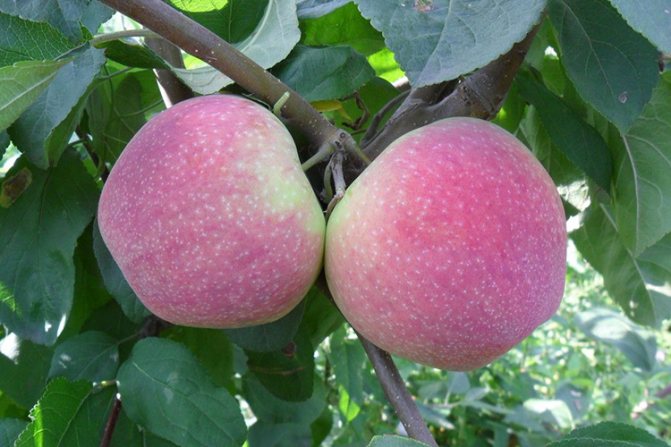

The variety is characterized by low self-pollination, because of this, in years with a rainy spring, the yield is seriously reduced. The placement of apiaries in the immediate vicinity of the gardens helps in this moment.
Table: advantages and disadvantages of the variety.
| pros | Minuses |
| Early maturity, yield, taste of apples | Low resistance to scab, mediocre self-pollination, medium frost resistance. |
A relative disadvantage is the cyclicity of fruiting in old (more than 10-12 years old) apple trees, which is disadvantageous for some categories of farms.
When grown in a private household, it is better to plant other varieties of apple trees.

